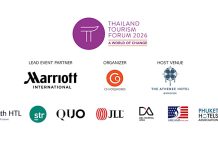LUANG PRABANG, Lao PDR, 10 June 2025: Lao PDR is set to welcome regional tourism leaders to the Mekong Tourism Forum (MTF) 2025 in the World Heritage town of Luang Prabang from 19 to 28 June.
In a special interview, HE Suanesavanh Vignaket, Minister of Information, Culture and Tourism (MICT), shares Lao PDR’s priorities for sustainable tourism, community development, and regional cooperation. With Luang Prabang recently recognised among the Green Destinations Top 100 Stories and new infrastructure enhancing connectivity with neighbouring countries, the Minister invites the world to experience a more connected, sustainable, and inclusive future for Greater Mekong Subregion tourism.

Q: Lao PDR welcomed over 4 million visitors in 2024, surpassing expectations. What key strategies or developments do you believe contributed most to this success?
A: In 2024, we proudly welcomed over 4.12 million international visitors, generating more than USD1 billion in tourism revenue. This achievement was driven by several key factors. First, the Lao PDR-China Railway has made cross-border travel faster and more comfortable, especially for regional travellers. Second, the “Visit Laos Year 2024” campaign helped to spotlight our diverse tourism offerings — from natural wonders and heritage towns to adventure and wellness tourism. We also improved visa policies and border infrastructure, making entry smoother for tourists. Moreover, coordinated marketing and capacity-building efforts at the provincial level helped ensure high-quality experiences nationwide. Looking ahead, we are also starting to embrace digital technologies such as 5G networks and tourism mobile applications to improve visitor services further and support sustainable tourism development.
Q: How significant is this event for Lao PDR and Luang Prabang, and what can delegates look forward to?
A: We are deeply honoured that Luang Prabang has been selected to host the Mekong Tourism Forum 2025. This opportunity is a source of great pride not only for Luang Prabang province but for the entire nation. Luang Prabang was recently recognised as one of the Green Destination Top 100 Stories of 2025 and has been acknowledged for its strong commitment to sustainable tourism and community development. Additionally, Luang Prabang is currently implementing a Smart and Integrated Urban Development Strategy. This project enables us to enhance tourism management, protect heritage sites, and promote balanced urban development. These initiatives reflect our commitment to harmonize preservation with innovation as tourism in the region continues to grow.
MTF 2025 will offer delegates a chance to experience this firsthand. Besides the main program, we invite delegates to explore some hidden gems nearby such as Ban Chan pottery village, Phanom Handicraft Centre, Sangkhong and Sanghai Handicraft villages. These places reflect the rich cultural heritage and natural beauty that make Luang Prabang truly unique.
Q: What are the country’s priorities to ensure tourism growth remains sustainable and benefits local communities?
A: It is indeed true that Lao PDR remains something of a hidden gem for many international visitors, but we are gradually welcoming an increasing number of travellers to our country. As this growth continues, our foremost priority is to ensure that it is both sustainable and inclusive. The government is placing a strong emphasis on promoting sustainable tourism and cultural preservation as key pillars for long-term economic and social development. These include the development of cultural villages, the revitalisation of traditional customs, the enhancement of libraries, museums, and heritage sites, as well as the elimination of outdated practices. A core focus of our approach is community-based tourism, where local people provide services and benefit directly from tourism-related activities. In 2024, more than 60% of tourism businesses were located outside major cities, indicating that opportunities are being spread to rural areas. With the continued support from our development partners, we are working to strengthen local capacities and ensure that tourism contributes meaningfully to both cultural preservation and environmental sustainability.
Q: How do you see connectivity shaping the future of tourism in Lao PDR and the Greater Mekong Subregion (GMS)?
A: Improved connectivity is fundamental to advancing tourism in the GMS. In this regard, the Lao PDR–China Railway has played a transformative role, having already served over 480,000 cross-border passengers. This vital link has significantly facilitated travel between Lao PDR and China. At the same time, the new road connecting Vientiane and Chiang Mai reduces travel time by approximately 3 hours and opens up exciting new tourism routes. We have also launched a new cross-border bus service between Udon Thani (in Thailand) and Vang Vieng (in Lao PDR) that further enhances land travel options for visitors. In addition to land and rail, we are working to enhance air connectivity. Lao Airlines and other regional carriers are expanding flight routes linking Lao PDR with ASEAN’s key cities, such as Bangkok, Hanoi, Ho Chi Minh, Kunming, and Chiang Mai. Strengthening air services is essential for promoting seamless multi-destination travel across the region.
These developments allow tourists to explore multiple destinations within a single trip. We are working closely with our GMS partners to develop multi-country tourism products and promote regional circuits. This not only enhances the appeal of the region as a whole but also ensures that the benefits of tourism are shared among all GMS countries.
Q: How important is provincial and community-based tourism development to Lao PDR’s national tourism strategy?
A: Provincial and community-based tourism development is a key pillar of Lao PDR’s national tourism strategy. Each of our provinces offers distinct and authentic experiences, and we strive to ensure that the benefits of tourism reach local communities nationwide. For example, Khammouane Province is developing eco-adventure tourism activities, such as zip-lining and kayaking. Meanwhile, Vientiane Capital has launched the “Vientiane’s Sustainable Tourism” initiative, which integrates new technologies, infrastructure upgrades, and environmentally-friendly transportation options to enhance the visitor experience while promoting sustainability.
To support these efforts, we have established the Destination Management Network (DMN). This platform brings together stakeholders from both public and private sectors at the national and provincial levels. Through the DMN and strategic public-private partnerships, we are promoting sustainable tourism models that not only support local livelihoods but also contribute to inclusive economic growth.
Q: Can you tell us more about the ASEAN Ecotourism Standard and Lao PDR’s role in developing regional initiatives like the ASEAN Ecotourism Corridor?
A: Yes, ecotourism is one of our key national priorities. Lao PDR has taken on an active role in fostering ecotourism under the ASEAN tourism cooperation framework. We were honoured to serve as the lead country coordinator in the development of the ASEAN Ecotourism Standard, which provides an essential set of guidelines designed to enhance the quality, sustainability, and consistency of ecotourism experiences across the region. In addition, we also actively supported the establishment of the ASEAN Ecotourism Corridor, which aims to encourage travellers to explore natural and rural areas responsibly across multiple ASEAN countries.
In Lao PDR, we are proud to offer a wide range of nature-based tourism experiences, including visits to national parks, protected areas, and ethnic minority communities. For example, Nam Et–Phou Louey National Park offers unique wildlife tracking experiences, while the Bolaven Plateau provides opportunities for scenic trekking. We believe that promoting ecotourism contributes not only to environmental conservation and cultural preservation but also directly supports the livelihoods of local communities across our region.
Q: How do you envision Lao PDR working with neighbouring countries to promote multi-country travel and sustainable tourism?
A: The Greater Mekong Subregion (GMS) holds great potential for cross-border tourism, driven by our shared cultural heritage, natural landscapes, and improving connectivity. Lao PDR is working in close partnership with our GMS neighbours through regional frameworks such as the GMS Economic Cooperation Program and ASEAN tourism cooperation to promote multi-country travel and sustainable tourism. We are engaged in collaborative efforts with GMS member countries to enhance infrastructure connectivity, develop joint travel products, and promote thematic tourism circuits that link our cultural, natural, and heritage sites across the region. In addition, Lao PDR participates in initiatives that support sustainable tourism standards, capacity building, and knowledge sharing among GMS countries. Through these collective efforts, we aim to foster a more inclusive, resilient and interconnected landscape in the GMS.
Q: How do you see the role of women in shaping the future of tourism in Lao PDR?
A: Women play an essential role at all levels of Lao PDR’s tourism sector. At the national level, the Ministry of Information, Culture and Tourism is proud to have many women in leadership positions, including the Vice Minister and several Director Generals. At the community level, women are at the forefront, running guesthouses, leading handicraft cooperatives, guiding visitors, and managing eco-tourism sites. Moreover, we are also encouraged by the efforts of organizations, such as the Women with Disabilities Association which are helping to bring Lao handicrafts to the global market. This reflects that tourism in Lao PDR is becoming more inclusive, supporting women, minorities and people with disabilities.
In 2024, women represented over 55% of the tourism workforce in Lao PDR. As we continue to grow our tourism sector, we remain committed to ensuring that tourism development leaves no one behind. We aim to empower women, ethnic minorities, and vulnerable groups to fully participate and benefit from the opportunities that tourism provides.
Q: Looking ahead beyond 2025, what is your vision for Lao PDR tourism development, and how can international partners and travellers support this journey toward a more inclusive, resilient, and sustainable tourism future?
A: Our vision is to build a tourism sector that is inclusive, resilient, and deeply rooted in sustainability. We are deeply committed to preserving Lao PDR’s rich cultural identity, supporting local communities, and safeguarding our natural heritage. Our goal is to continue offering authentic experiences that reflect the heart of who we are, ensuring that tourism brings benefits to all while honouring our environment and cultural values.
We welcome international partnerships to support areas like training and capacity building, sustainable destination management, digital transformation, and climate resilience. At the same time, we encourage travellers to visit Lao PDR with open hearts by choosing eco-friendly options, supporting local businesses, and respecting our cultural values. Through shared efforts and cooperation, we believe that Lao PDR can become a model for sustainable tourism not only in Southeast Asia but globally.
The priorities and vision shared by HE Suanesavanh Vignaket reflect the spirit of MTF 2025 — a forum to advance sustainable, inclusive tourism in the Greater Mekong Subregion. Register at www.mekongtourism.org
(SOURCE: Mekong Tourism Coordinating Office)






